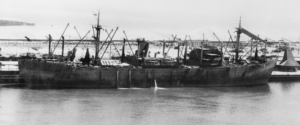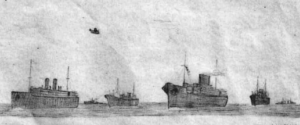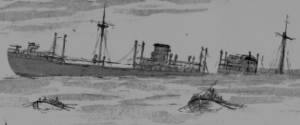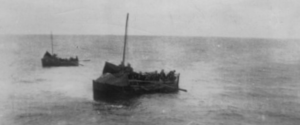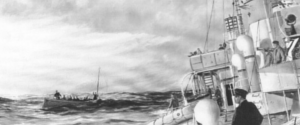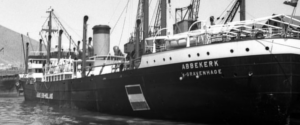Abbekerk leaves Trinidad for England

15 August 1942.
The empty ship took an astonishing amount of sugar in all its five holds, absolutely full to the top deck. I know the Captain had been in touch with the shipyards in Curacao to find out if his ship could go into dry-dock for a good scrub to get rid of all fouling of the hull. The answer was negative because of lack of space. Of course this was a big disappointment. The ship, fully loaded, was now floating meters deeper in the water and this again reduced the speed significantly.
Yet we were considered as if we were as fast as before, because we received orders that we had to sail independently, without any protection, to England.
We left the harbour of Port of Spain in Trinidad on 15th August 1942.
Assistent engineer Adriaan Kik
Abbekerk isn’t capable any more to reach her usual cruising speed of 17 knots. Along with the zigzagging her average speed is 15.5 knots. This seems a marginal difference but it is significant.
To be able to attack, a U-boat has to be within a distance of a few kilometers of the ship. Preferably in front of it for the torpedo’s, which cruise at 30 knots, can easily intercept the ship. A fast sailing ship is only at risk if she sails directly at the U-boat and passes it within a few kilometers. Those are slim chances. When the U-boat is only a little faster then the freighter she has to overtake her (sailing on the surface) and then wait for her submerged. The U-boat has to make sure she is not noticed otherwise the ship will sail an evasive course and possibly even shoot at the submarine.
A U-boat has a top speed of around17 knots. A ship sailing at that speed or faster can virtually not be overtaken and is relatively safe. 1.5 knots slower provides a surmountable margin, as will be proven.
Abbekerk’s intended route
Sketch of an idyllic Trinidad drawn in 1943 by Piet Saman who sailed with engineer Adriaan Kik on the SS Maaskerk later in the war
When we sailed on the 15 of August we quickly became aware the U-boats were very active in this region. On the day of departure we saw the bow of a ship floating by and later that day we came across a Norwegian lifeboat. We offered to take them on board but since they allready spotted the mountains of Trinidad on the horizon, they kindly refused. In retrospect a very wise descision.
Third mate Jacob Visser
This lifeboat was probably from the Norwegian D/S Bill which was sunk by U155 on July 29th. The last of three lifeboats reached Trinidad on August 15th.

